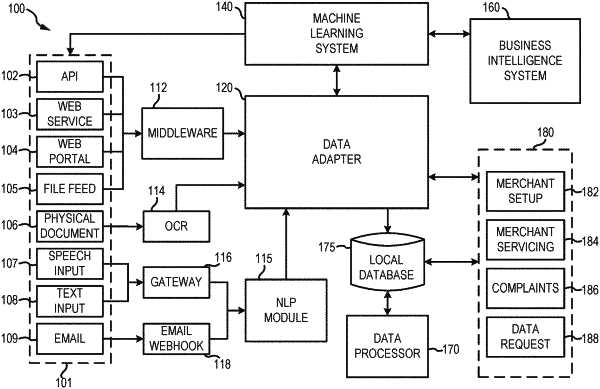| CPC G06N 20/00 (2019.01) [G06N 5/04 (2013.01); G06Q 30/018 (2013.01)] | 20 Claims |

|
1. A method, comprising:
receiving, by a computer-based system, a data input from an input channel, wherein the data input comprises at least one data field that defines a format of the data input;
retrieving, by a computer-based system, one or more data structures from a database in electronic communication with the computer-based system, wherein each of the one or more data structures comprises a request type, a format, an input channel, and acknowledgement requirements;
comparing, by the computer-based system, the at least one data field of the data input to the format of each of the one or more data structures to determine whether the format of the data input corresponds to the format of a data structure;
when the format of the data input corresponds to the format of a data structure, performing operations comprising:
reformatting, by the computer-based system, the at least one data field of the data input such that the data input is in the format defined by the format of the data structure that is consumed by downstream platforms, wherein the reformatting comprises encryption, aggregation, and augmentation; and
storing, by the computer-based system, the reformatted data input at the database; when the format of the data input is determined to be unknown, performing operations comprising:
predicting, by the computer-based system, a format associated with the data input, wherein the predicting is performed by one or more machine learning models, wherein the one or more machine learning models have been trained on the one or more data structures and reformatted data stored at the database;
reformatting, by the computer-based system, the data input based on the format generated by the one or more machine learning models;
updating, by the computer-based system, the database by storing the reformatted data input at the database;
training, by the computer-based system, each of the one or more machine learning models with the reformatted data input stored at the updated database; and
analyzing, by the computer-based system using machine learning, the at least one data field of the data input by one or more of the machine learning models to generate a machine learning analysis output that provides an insight into the format of the data input,
wherein the standardized format organizes the at least one data field of the data input in a predefined order, and
wherein the insight into the format of the data input comprises at least one of a trend, a causal event, and a correlated event of the data input.
|